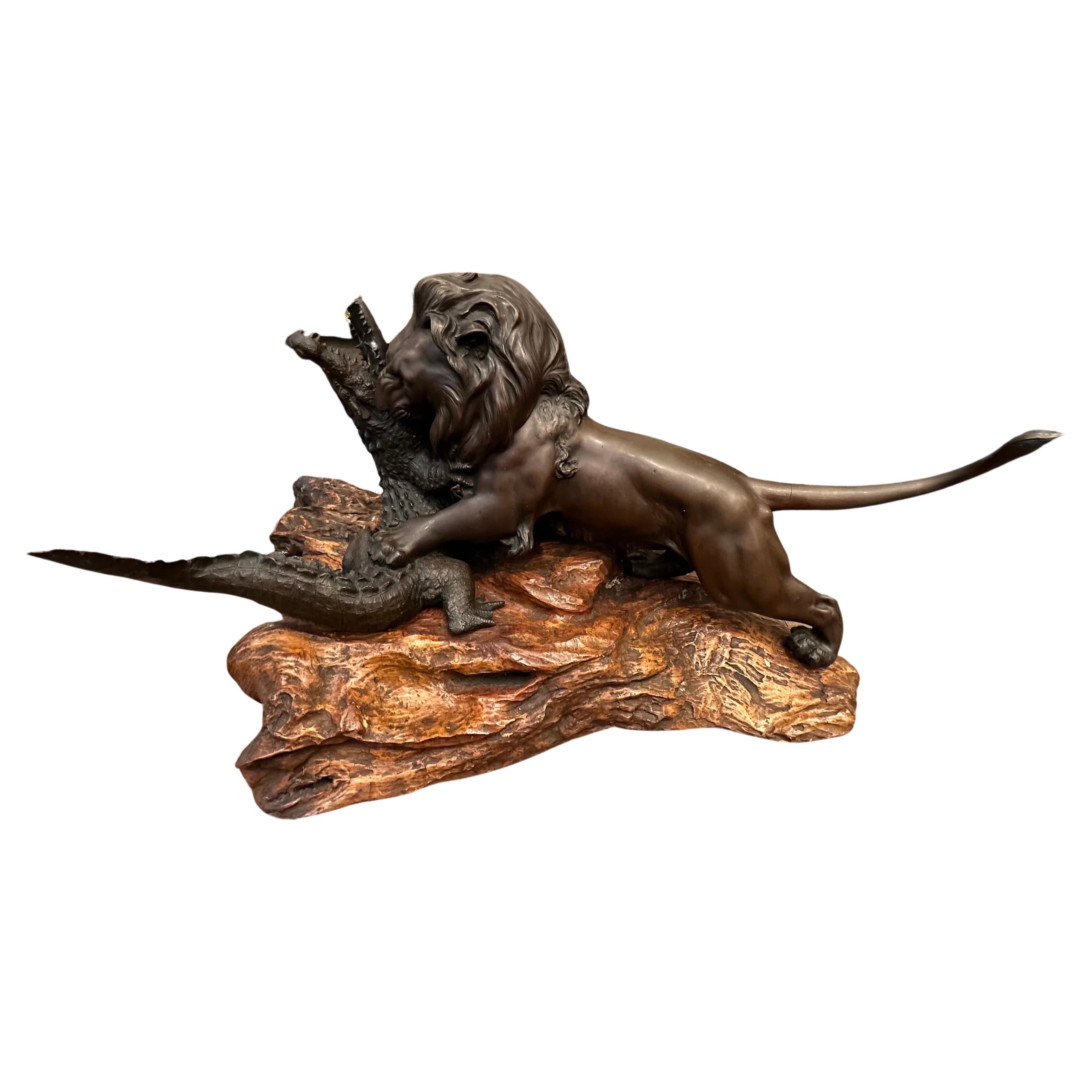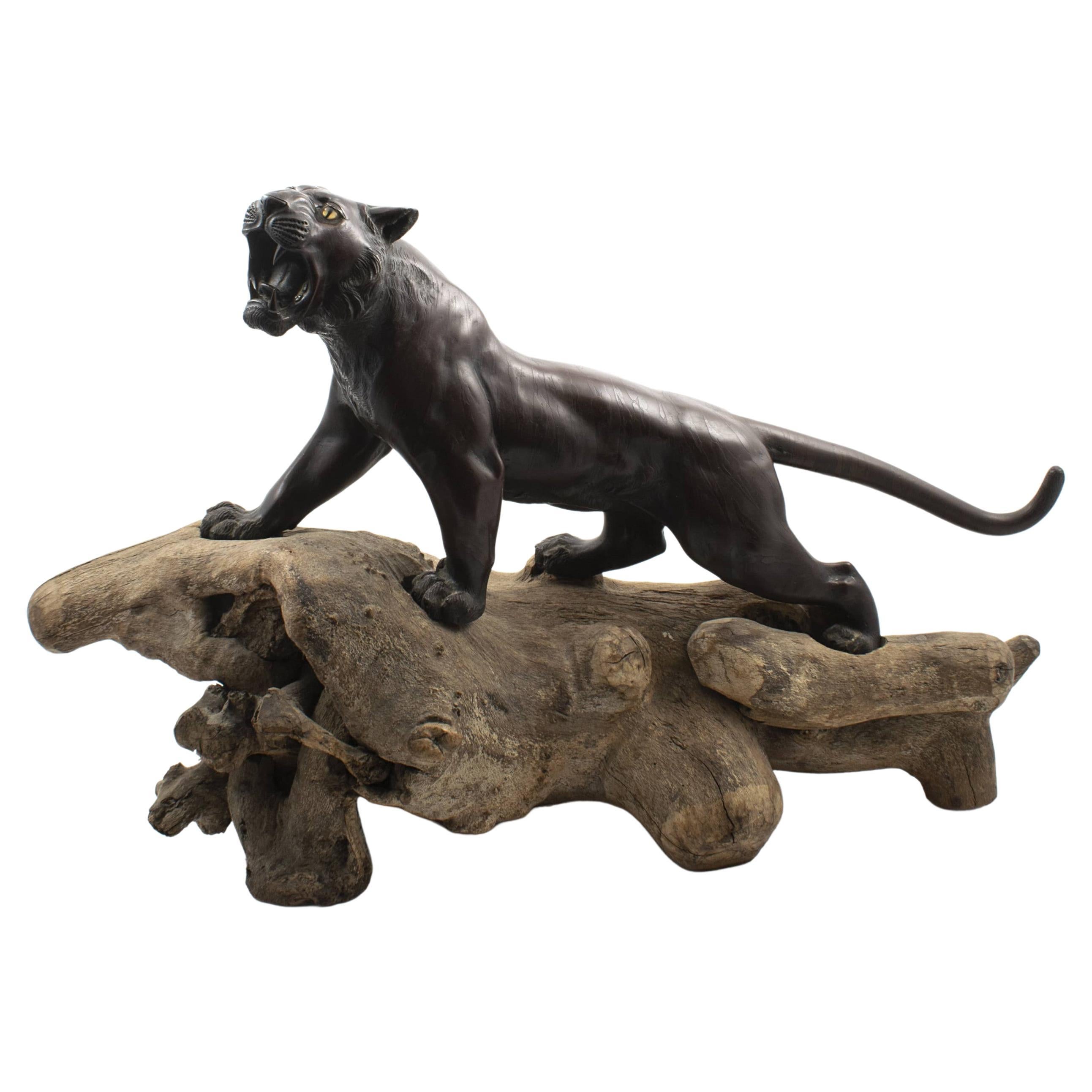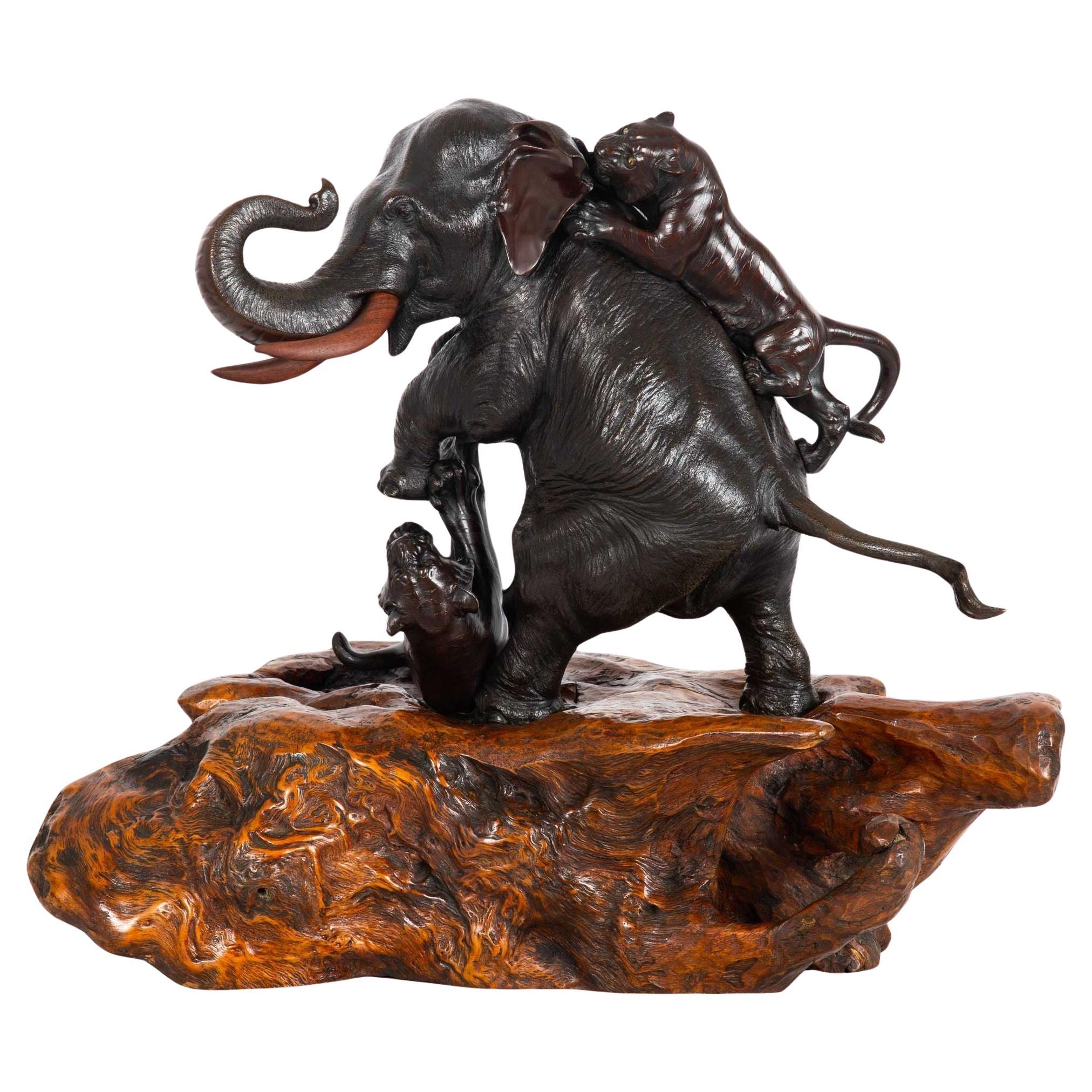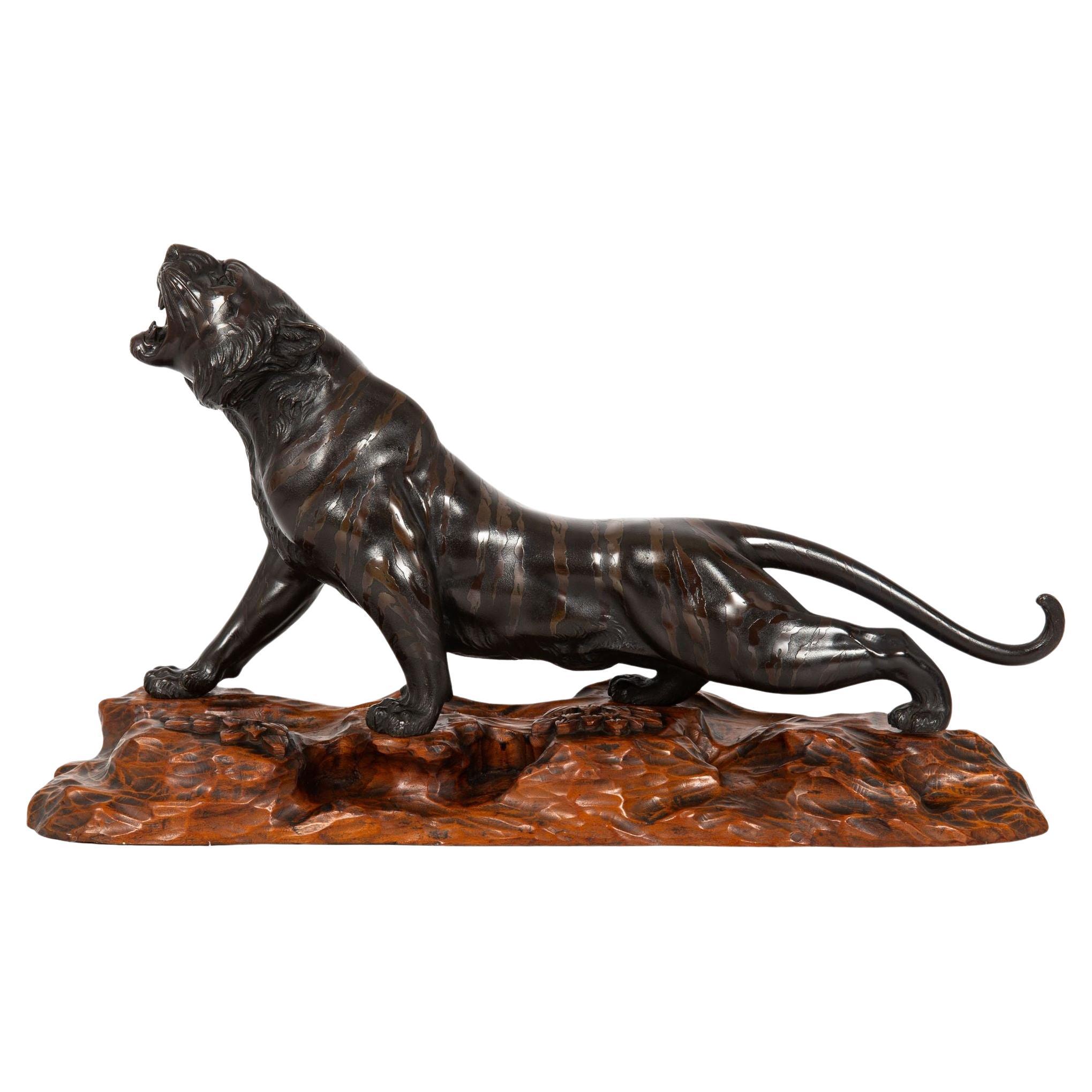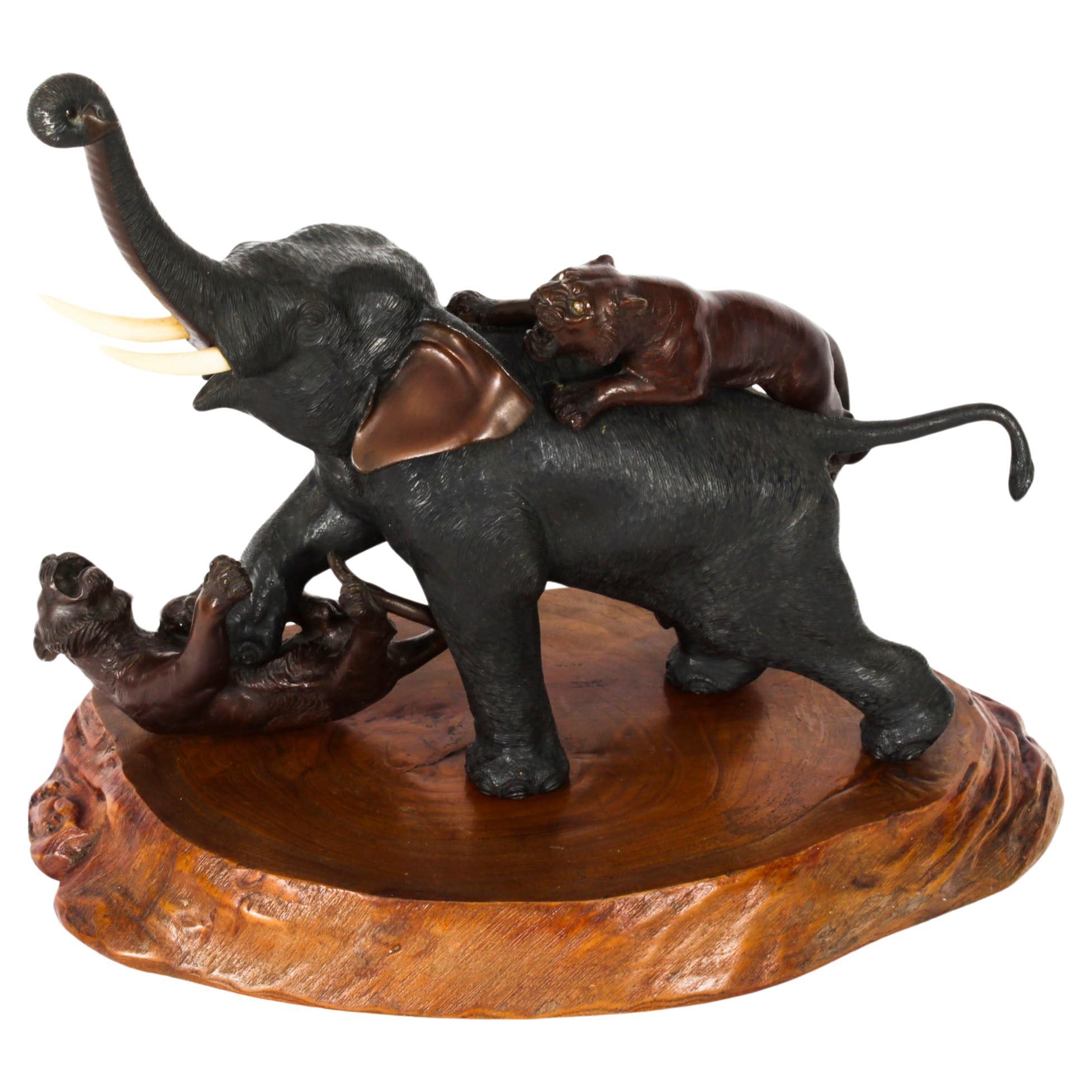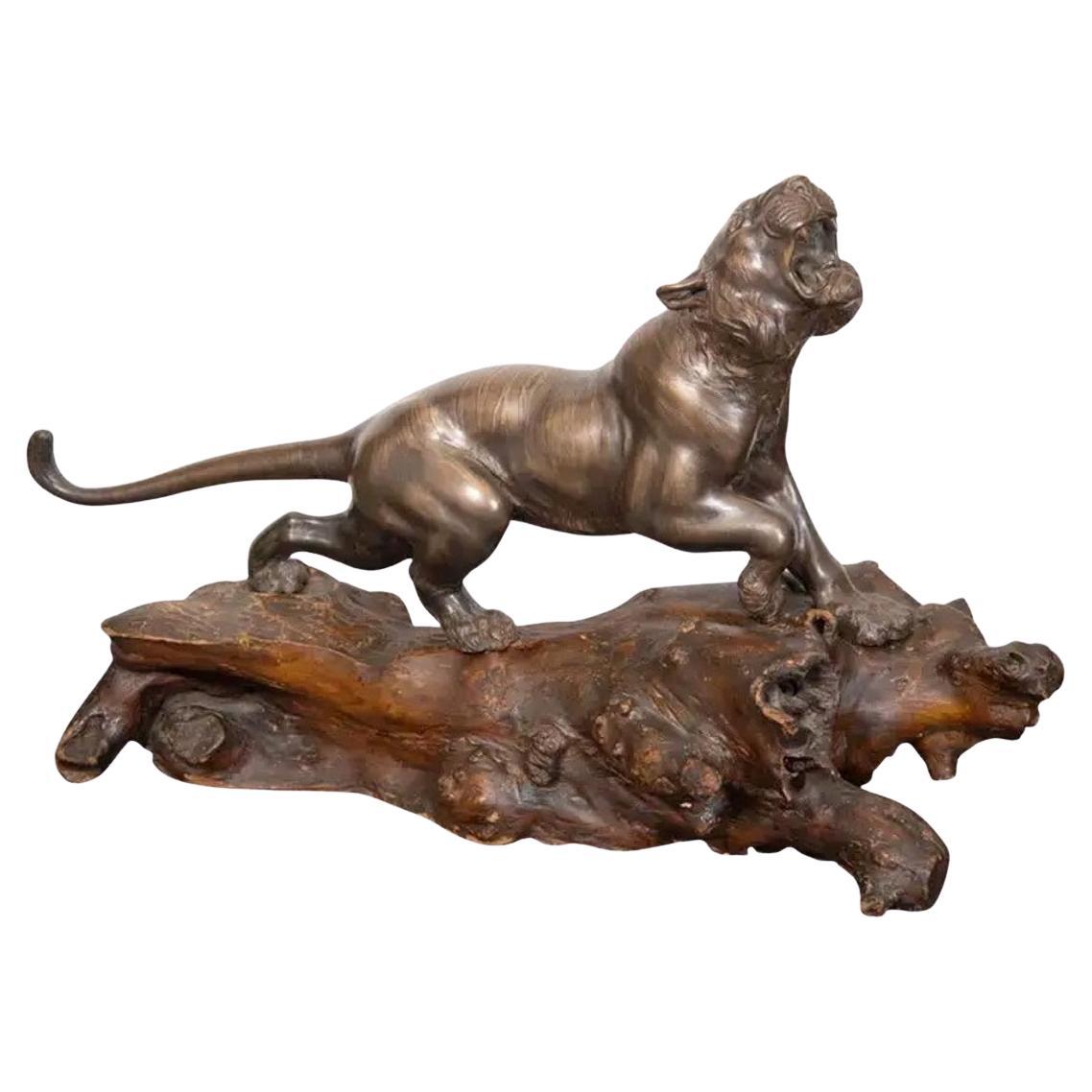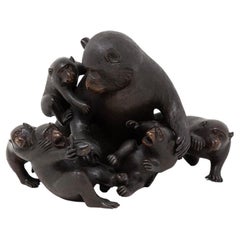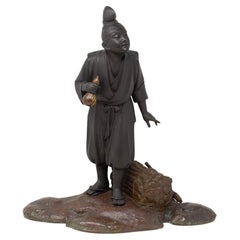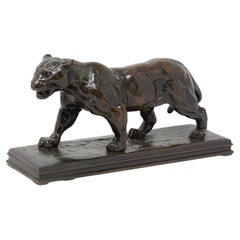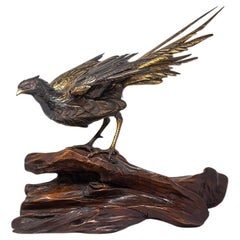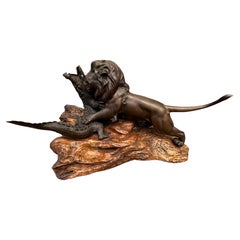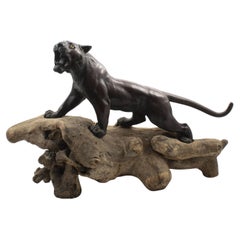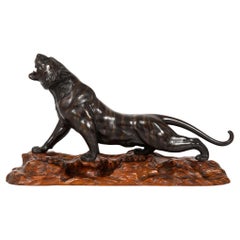Items Similar to Japanese Meiji Period Bronze Group Bear & Alligator by Yoshimitsu
Want more images or videos?
Request additional images or videos from the seller
1 of 12
Japanese Meiji Period Bronze Group Bear & Alligator by Yoshimitsu
$5,510.58
£3,995
€4,706.55
CA$7,569.31
A$8,416.64
CHF 4,406.26
MX$102,810.81
NOK 55,369.03
SEK 52,085.67
DKK 35,134.07
About the Item
The Japanese group comprises of a Bear being attacked by a large alligator. The alligator jumping on the back of the Bear with mouth wide opening showing its razor sharp teeth. The bear looking back at the Alligator with mouth also wide open snarling at the attacking predator. The group of natural bronze casting with life like features to both the Bears fur and the scales of the Alligator. Signed on the belly of the Bear in a rectangle reserve 芳光作 Yoshimitsu-saku (made by Yoshimitsu). The group dates to the Meiji period (1868-1912) circa 1890. The Japanese group is stood upon a scrollwork foot wooden stand to emphasise the and lift the figure.
Meiji Period is an era of Japanese history that spanned from 1868 to 1912. It was the first half of the Empire of Japan, when the Japanese people began to build a paradigm of a modern, industrialised nation state and emergent great power, influenced by Western countries and aesthetics. As a result of radically different ideas, the changes to Japan were profound and it affected the social structure, politics, economy, military, and foreign relations across the board. The period corresponded to the reign of Emperor Meiji and was preceded by the Keio era and was succeeded by the Taisho era.
Cultural Art during the Meiji Period was of particular interest to the government and they overhauled the art export market which in turn promoted Japanese arts via various world’s fairs, beginning in Vienna at the world fair in 1873. The government heavily funded the fairs and took an active role organising how Japan’s culture was presented to the world including creating a semi-public company named Kiritsu Kosho Kaisha (First Industrial Manufacturing Company). The Kiritsu Kosho Kaisha was used to promote and commercialise exports of Japanese art and established the Hakurankai Jimukyoku (Exhibition Bureau) to maintain quality standards. For the 1876 Centennial International Exhibition in Philadelphia, the Japanese government created a Centennial Office and sent a special envoy to secure space for the 30,000 items that would be displayed. The Imperial Household also took an active interest in arts and crafts, commissioning works by select artists to be given as gifts for foreign dignitaries further emphasising the high quality and importance of Japanese art. Just before the end of the 19th century in 1890, the Teishitsu Gigeiin (Artist to the Imperial Household) system was created to recognise distinguished artists. These artists were selected for their exceptionally high quality wares and talent in their own industry. Over a period of 54 years Seventy artists were appointed, amongst these were ceramicist Makuzu Kozan and cloisonné enamel artist Namikawa Yasuyuki.
Bronze is an alloy consisting primarily of copper with approximately 12–12.5% tin and often with the addition of other metals (including aluminium, manganese, nickel, or zinc) and sometimes non-metals, such as phosphorus, or metalloids such as arsenic or silicon depending on the age of the bronze and its origin. The additions of other metals produce a range of alloys that are usually harder than copper alone and carry useful properties such as strength. The earliest known use of bronze dates to the 5th millennium BCE from Iranian plateau, the bronze mix consists of arsenical copper and copper-arsenide. The earliest tin-copper-alloy recovered is dated to circa 4650 BCE and was found in Plocnik, Serbia. It is believed to have been smelted from a natural tin-copper ore.
Measurements Figure 13cm High x 25.5cm Wide x 18cm Deep (5.12 x 10 x 7.1 Inches) Stand 3cm High x 32cm Wide x 22.5cm Deep (1.18 x 12.6 x 8.86 Inches)
- Dimensions:Height: 5.12 in (13.01 cm)Width: 10 in (25.4 cm)Depth: 7.1 in (18.04 cm)
- Style:Meiji (Of the Period)
- Materials and Techniques:
- Place of Origin:
- Period:
- Date of Manufacture:Circa 1890
- Condition:
- Seller Location:Newark, GB
- Reference Number:Seller: BADD1stDibs: LU6971236081322
About the Seller
5.0
Gold Seller
Premium sellers maintaining a 4.3+ rating and 24-hour response times
Established in 2019
1stDibs seller since 2022
38 sales on 1stDibs
Typical response time: 2 hours
- ShippingRetrieving quote...Shipping from: Newark, United Kingdom
- Return Policy
Authenticity Guarantee
In the unlikely event there’s an issue with an item’s authenticity, contact us within 1 year for a full refund. DetailsMoney-Back Guarantee
If your item is not as described, is damaged in transit, or does not arrive, contact us within 7 days for a full refund. Details24-Hour Cancellation
You have a 24-hour grace period in which to reconsider your purchase, with no questions asked.Vetted Professional Sellers
Our world-class sellers must adhere to strict standards for service and quality, maintaining the integrity of our listings.Price-Match Guarantee
If you find that a seller listed the same item for a lower price elsewhere, we’ll match it.Trusted Global Delivery
Our best-in-class carrier network provides specialized shipping options worldwide, including custom delivery.More From This Seller
View AllJapanese Meiji Period Bronze Monkey Group Sculpture Okimono Shosai
Located in Newark, England
Featuring Seven Japanese Macaques
Form our Japanese collection, we are delighted to offer this Japanese Bronze Monkey Group by Shosai. The Japanese Bronze Group displaying a male father monkey and his infants playing around and being mischievous with Persimmon fruit. The monkeys modelled as Japanese macaque monkeys (snow monkey). The bronze okimono is beautifully patinated with a highly lifelike and naturalistic casting signed to the underside Shosai 正齊鋳. The Bronze group dates to the Meiji Period (1868-1912) circa 1885.
Japanese macaque (snow monkey) is a terrestrial Old World monkey species that is native to Japan. They are known as snow monkeys because some live in areas where snow covers the ground for long periods each year hence their nickname. No other non-human primate lives further north or in a colder climate than the snow monkey. Individuals have brownish grey fur, pinkish-red faces, and short tails. Two subspecies are known and their conservation Status is of least concern. In Japan, the species is known as Nihonzaru ニホンザル, 日本 (Japan/Nihon) and saru 猿 (monkey) to distinguish it from other primates, but the Japanese macaque is the only species of monkey in Japan.
The Japanese macaque features heavily in the religion, folklore, and art of Japan, as well as in proverbs and idiomatic expressions in the Japanese language. They are often seen in paintings, block prints and represented in all manner of carvings from Okimono to netsuke. Many of these art forms reside in the world’s most famous museums and collections, some of the most prominent pieces by artists such as Mori Sosen and Kawanabe Kyosai. In Shinto belief (Japan’s indigenous religion/nature religion) legendary mythical beasts known as raiju sometimes appeared as monkeys and kept Raijin (the god of lightning/storms) company. In another well known tale the three wise monkeys who warn people to “see no evil, hear no evil and speak no evil” can be seen depicted in relief over the door of the famous Tosho-gu shrine in Nikko.
Meiji Period was an era of Japanese history that spanned from 1868 to 1912. It was the first half of the Empire of Japan, when the Japanese people began to build a paradigm of a modern, industrialised nation state and emergent great power, influenced by Western countries and aesthetics. As a result of radically different ideas, the changes to Japan were profound and it affected the social structure, politics, economy, military, and foreign relations across the board. The period corresponded to the reign of Emperor Meiji and was preceded by the Keio era and was succeeded by the Taisho era.
Cultural Art during the Meiji Period was of particular interest to the government and they overhauled the art export market which in turn promoted Japanese arts via various world’s fairs, beginning in Vienna at the world fair in 1873. The government heavily funded the fairs and took an active role organising how Japan’s culture was presented to the world including creating a semi-public company named Kiritsu Kosho Kaisha (First Industrial Manufacturing Company). The Kiritsu Kosho Kaisha was used to promote and commercialise exports of Japanese art and established the Hakurankai Jimukyoku (Exhibition Bureau) to maintain quality standards. For the 1876 Centennial International Exhibition in Philadelphia, the Japanese government created a Centennial Office and sent a special envoy to secure space for the 30,000 items that would be displayed. The Imperial Household also took an active interest in arts and crafts, commissioning works by select artists to be given as gifts for foreign dignitaries further emphasising the high quality and importance of Japanese art. Just before the end of the 19th century in 1890, the Teishitsu Gigeiin (Artist to the Imperial Household) system was created to recognise distinguished artists. These artists were selected for their exceptionally high quality wares and talent in their own industry. Over a period of 54 years Seventy artists were appointed, amongst these were ceramicist Makuzu Kozan and cloisonné enamel artist...
Category
Antique Late 19th Century Japanese Meiji Sculptures and Carvings
Materials
Bronze
Japanese Bronze Okimono Sculpture by Yamamoto Kozan
Located in Newark, England
YOUNG MAN WOOD CUTTING
From our Japanese collection, we are pleased to offer this Japanese Bronze Okimono by Yamamoto Kozan. The Japanese Bronze Sculpture cast in Bronze with a natu...
Category
Early 20th Century Japanese Meiji Sculptures and Carvings
Materials
Bronze
French Bronze Jaguar Qui Marche No. 2 (Walking Jaguar) by Antoine Barye
By Antoine-Louis Barye
Located in Newark, England
SIGNED BAYRE
From our Sculpture collection, we are delighted to offer this Jaguar Qui Marche No. 2 (Walking Jaguar) Bronze by Antoine-Louis Barye. The Jaguar Qui Marche translates ...
Category
Antique Late 19th Century French Belle Époque Animal Sculptures
Materials
Bronze
Japanese Bronze Pheasant Okimono Genryusai Seiya
Located in Newark, England
Unusual Casting of a Pheasant in Flight
From our Japanese collection, we are delighted to offer this Japanese bronze okimono of a Pheasant upon a naturalistic root wood base. The Ph...
Category
Antique Late 19th Century Japanese Meiji Sculptures and Carvings
Materials
Bronze
Antique French Bronze Pheasant and Weasel by Jules Moigniez
By Jules Moigniez
Located in Newark, England
Pheasant and Weasel
From our Sculpture collection, we are delighted to offer this French Bronze Pheasant by Jules Moigniez. The French Bronze of good scale cast with a large male Pheasant clambering upon a rocky outcrop startled by a Weasel hiding within the foliage. The Pheasant naturalistically cast with individual feathers visible, sharp claws and spurs above the foot. The Weasel sits hidden in the foliage visible from viewing the French Bronze from the side as it shocks the Pheasant. The French Bronze signed to the front left on a rock face J. Moigniez (Jules Moigniez). The bronze sculpture dates to the late 19th century belle époque period Circa 1870.
Jules Moigniez (1835-1894) was born at Senlis, Oise, just north of Paris, France on the 28 May 1835 the son of a metal gilder. Moigniez studied under Paul Comoléra (1813-1890) a specialist Animalia sculptor. It is clear that Moigniez’s career in Animalia was passed down from his tutors specialism in Animalia and in particular birds. Moigniez father bought a foundry specifically to cast his son’s sculptures. This gave Moigniez a huge advantage compared to other artist as it greatly reduced his costs during manufacturing and increased productivity keeping the process in-house. Moigniez throughout his career became known for this Animalia sculptures...
Category
Antique Late 19th Century French Belle Époque Animal Sculptures
Materials
Bronze
Japanese Pair of Large Antique Meiji Period Bronze and Mixed Metal Vases
Located in Newark, England
Inlaid with Gold and Silver
From our Japanese collection, we are thrilled to offer a Japanese Pair of Meiji Period Bronze Vases. The Japanese Bronze Vases of elongated form each sur...
Category
Antique Late 19th Century Japanese Meiji Vases
Materials
Metal, Gold, Silver, Bronze
You May Also Like
Meiji Period Japanese Bronze Lion And Crocodile On Wooden Base
Located in Southall, GB
A delightful Meiji Period Japanese bronze lion and crocodile on a root wood base. A skilfully hand crafted piece that encapsulates the splendour of each animal from the lush lions mane and muscular body to the scales and ridges of the toughened skin of the crocodile. The expressions of both the lion and the crocodile are clear and crisp, caught in the midst of a battle for life and death. The lions eyes...
Category
Antique Mid-19th Century Japanese Meiji Animal Sculptures
Materials
Bronze
$7,172 Sale Price
20% Off
Large Japanese Tiger in Patinated Bronze, Signed. MEIJI / TAISHO
By Kosai Taisho
Located in Kastrup, DK
Japanese tiger in reddish brown patinated bronze with glass eyes.
Signed.
Made in very high quality on original plinth root wood.
Meiji period 1852-1...
Category
Early 20th Century Japanese Meiji Animal Sculptures
Materials
Bronze
Large Japanese Meiji Bronze Sculpture Elephant and Tigers by Mitsumoto
Located in Shippensburg, PA
MEIJI PERIOD BRONZE OKIMONO OF ELEPHANT BEING ATTACKED BY TWO TIGERS
Workshop of Omori Mitsumoto (kôgen), 大森光元, Japan, circa 1900
Cast and patinated bronze, hardwood base, two carved...
Category
Early 20th Century Japanese Meiji Animal Sculptures
Materials
Bronze
Fine Japanese Meiji Bronze Okimono Sculpture of Tiger by Mitani
Located in Shippensburg, PA
An exceedingly fine Japanese bronze okimono of a Roaring Tiger from the Meiji period, it exhibits the finest chiseling and articulating of detail. The sleek beast is cast in a way th...
Category
Antique 19th Century Japanese Meiji Animal Sculptures
Materials
Bronze
Antique Large Japanese Bronze Elephant & Tigers Meiji Period 19th Century
Located in London, GB
A beautiful large Japanese Meiji Period patinated bronze study of an elephant with tigers, signed on the belly, Meiji period, 1868-1912, and late...
Category
Antique Late 19th Century Figurative Sculptures
Materials
Bronze
A 19th Century Japanese Signed Bronze Tiger Sculpture, Circa 1860s
Located in New York, NY
19th Century Japan
Tiger
Bronze Sculpture
Circa 1860s
DIMENSIONS
Tiger with base is 33" L x 21" H x 21" D
The bronze tiger is 28" L x 15" H
ABOUT
A finely cast bronze sculpture of a...
Category
Antique 1860s Japanese Japonisme Animal Sculptures
Materials
Bronze
More Ways To Browse
Emperor Japan
Iran Objects
Tinned Copper
Japanese Metal Sculpture
Bear Fur
Industrial Sculpture Stand
Meiji Figure
Antique Tinned Copper
Alloy Sculpture
Japanese Cloisonne Bronze
Meiji Bronze Sculptures
Animal Teeth
Large Carved Wood Bear
Antique Alligator
Large Bronze Bear Sculpture
Cloisonne Sculpture
Japanese Bronze Figure
Bronze Military Sculpture
